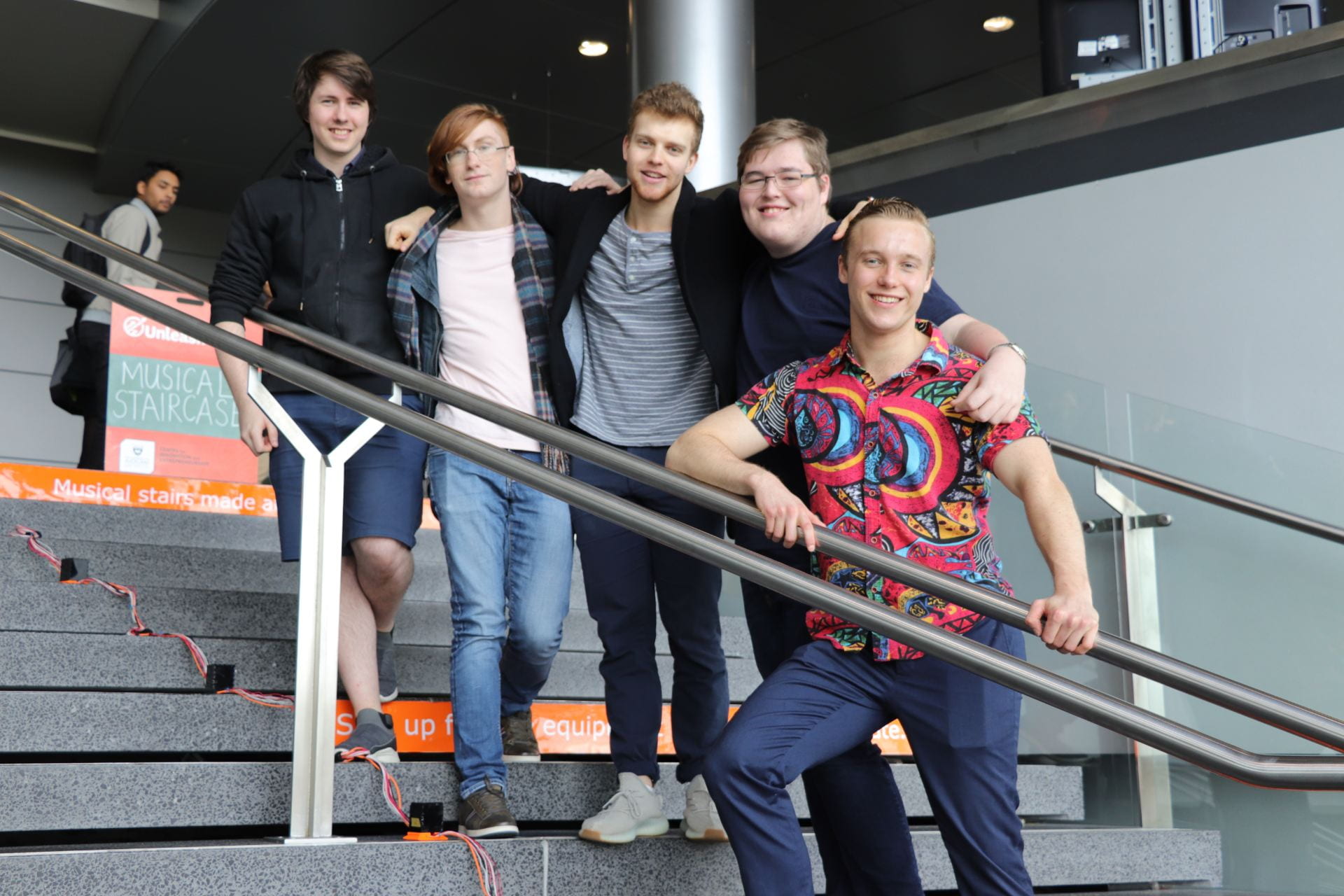
NEWSROOM
Musical stairs latest endeavour in student startup’s climb to success
Shwoop is an experiential marketing startup initiated by Business, Music and Engineering students at the University of Auckland. Their latest initiative is a portable ultrasonic installation that was used to transform stairs in the Sir Owen G Glenn building into musical stairs. The installation was created using equipment in the Centre for Innovation and Entrepreneurship’s Unleash Space. The Centre commissioned creation of the stairs to be used to raise awareness of the existence of the University’s innovation hub so that other students might be inspired to visit Unleash Space and use the equipment for their own inventions.
Over the course of the installation dozens of students and staff interacted with the stairs. Videos of the stairs in action with a link to the Unleash Space website were viewed over 12,000 times. Co-founder Jamie McDonald said that it was a great learning experience to test hypotheses and assumptions about how people have fun and interact with each other in a novel environment. “I personally monitored the stairs and its interactions for about 8 hours. The overwhelming majority of people engaged in some way, whether it was running up and down the stairs, sharing their experience on social media or making a connection with a stranger to make music. The highlight for me was a group of med students who came from the Grafton Campus and waited an hour while I did some software debugging just to play on the stairs”.
Hayden Moore was responsible for much of the construction of the hardware and coding of software. “The main problem to figure out was what sensing hardware to use to detect when the steps were stepped on. The easiest and most tactile system would have been physical force or pressure sensors under a board on the step but this could be seen as a health and safety risk. We could have also used infrared or laser light gates but in the bright OGGB foyer they may be subject to interference. They also take a lot longer to set up and this needed to be an installation that could be set up and removed quickly. We ended up going with ultrasonic sonar. Sonar works by emitting an ultrasonic (beyond human hearing) sound pulse. If the pulse hits someone’s foot, it is reflected and detected so we know that someone is standing on the step. We used an Arduino (microcontroller) to read distance from the ultrasonic sensors. It sends the distances to a Raspberry Pi – a miniature computer that we use to process audio. We ran into a lot of problems regarding ultrasonic interference and detection sensitivity and lag but managed to fix most of them by playing with the software and using different sensor scanning configurations. The project was definitely a big learning experience but the result didn’t turn out too bad!”
The Shwoop team regularly use Unleash Space. Hayden says “Unleash Space has been instrumental in our ability to make projects like this. The staff are always interested in what we are doing and happy to help out. We primarily used the 3D printers, laser cutter and soldering station in this project. I love how much technology we have access to and how we can combine different equipment in a million different ways to make new things.”
Jamie says that Shwoop’s big idea is to turn cities into playgrounds. “We’re focused on simultaneously creating software platforms and Internet of Things platforms as tools to ignite moments of fun and childish awe in people”.
Shwoop were selected as a finalist in the University’s flagship Velocity $100k challenge in 2018. They have previously worked with Auckland Public Library and New World on installations and are in talks with a number of government departments and corporates on a variety of future projects. Their next project is an app based game that is part treasure hunt, part Amazing Race.


Shwoop is an experiential marketing startup initiated by Business, Music and Engineering students at the University of Auckland. Their latest initiative is a portable ultrasonic installation that was used to transform stairs in the Sir Owen G Glenn building into musical stairs. The installation was created using equipment in the Centre for Innovation and Entrepreneurship’s Unleash Space. The Centre commissioned creation of the stairs to be used to raise awareness of the existence of the University’s innovation hub so that other students might be inspired to visit Unleash Space and use the equipment for their own inventions.
Over the course of the installation dozens of students and staff interacted with the stairs. Videos of the stairs in action with a link to the Unleash Space website were viewed over 12,000 times. Co-founder Jamie McDonald said that it was a great learning experience to test hypotheses and assumptions about how people have fun and interact with each other in a novel environment. “I personally monitored the stairs and its interactions for about 8 hours. The overwhelming majority of people engaged in some way, whether it was running up and down the stairs, sharing their experience on social media or making a connection with a stranger to make music. The highlight for me was a group of med students who came from the Grafton Campus and waited an hour while I did some software debugging just to play on the stairs”.
Hayden Moore was responsible for much of the construction of the hardware and coding of software. “The main problem to figure out was what sensing hardware to use to detect when the steps were stepped on. The easiest and most tactile system would have been physical force or pressure sensors under a board on the step but this could be seen as a health and safety risk. We could have also used infrared or laser light gates but in the bright OGGB foyer they may be subject to interference. They also take a lot longer to set up and this needed to be an installation that could be set up and removed quickly. We ended up going with ultrasonic sonar. Sonar works by emitting an ultrasonic (beyond human hearing) sound pulse. If the pulse hits someone’s foot, it is reflected and detected so we know that someone is standing on the step. We used an Arduino (microcontroller) to read distance from the ultrasonic sensors. It sends the distances to a Raspberry Pi – a miniature computer that we use to process audio. We ran into a lot of problems regarding ultrasonic interference and detection sensitivity and lag but managed to fix most of them by playing with the software and using different sensor scanning configurations. The project was definitely a big learning experience but the result didn’t turn out too bad!”
The Shwoop team regularly use Unleash Space. Hayden says “Unleash Space has been instrumental in our ability to make projects like this. The staff are always interested in what we are doing and happy to help out. We primarily used the 3D printers, laser cutter and soldering station in this project. I love how much technology we have access to and how we can combine different equipment in a million different ways to make new things.”
Jamie says that Shwoop’s big idea is to turn cities into playgrounds. “We’re focused on simultaneously creating software platforms and Internet of Things platforms as tools to ignite moments of fun and childish awe in people”.
Shwoop were selected as a finalist in the University’s flagship Velocity $100k challenge in 2018. They have previously worked with Auckland Public Library and New World on installations and are in talks with a number of government departments and corporates on a variety of future projects. Their next project is an app based game that is part treasure hunt, part Amazing Race.
EMAIL
CIE@AUCKLAND.AC.NZ
POSTAL ADDRESS
THE UNIVERSITY OF AUCKLAND BUSINESS SCHOOL
PRIVATE BAG 92019, AUCKLAND













